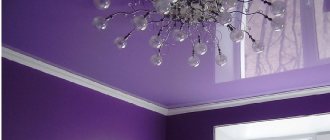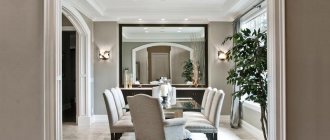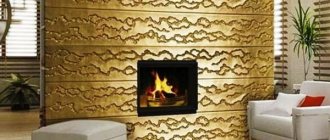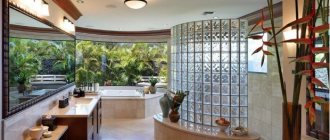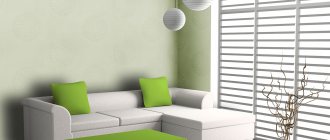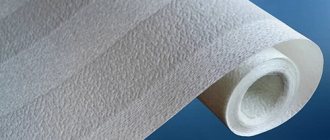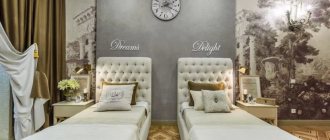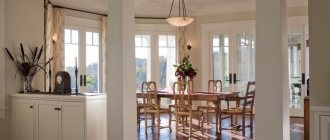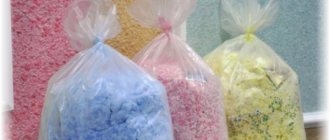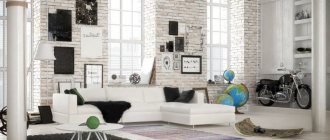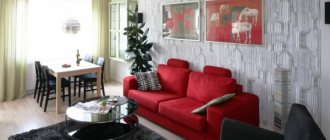What is glass wallpaper?
Fiberglass wallpaper is a decorative wall covering made from special glass.
- A special material is heated to the highest temperature, and while the glass is still warm, its fibers begin to be drawn out to make yarn.
- The drawn yarn can be of different types and have its own thickness.
- The resulting material will be further used to create fabric. The front side of fiberglass wallpaper cannot be distinguished from decorative weaving, which is performed using different techniques.
Fiberglass wallpaper is perfect for gluing any surfaces, such as concrete, plastic, metal, wood, plasterboard, brick and chipboard. Before applying wallpaper, you should seal the cracks and coat the wall with a primer. Thanks to glass fibers, the service life of wallpaper is at least 15 years, and if properly cared for - 30 years. If you get tired of the color of the canvas, you can always change it with paint without harming the appearance.
Most often, this wallpaper is used for painting.
Compound
Fiberglass is made only from natural materials that do not emit harmful substances.
The composition of such wallpaper includes the following components:
- glass,
- quartz sand,
- clay,
- dolomite,
- lime,
- soda.
At the initial stage, all components must be placed in briquettes, which, when heated, will melt and stretch into threads of the required thickness. In order to weave fabric from threads, special equipment is needed. The final stage is covering the wallpaper with a special solution, which consists of modified starch.
Specifications
NameMeaning
| Life time | more than 30 years |
| Possibility of coloring | Coloring up to 20 times |
| Standard size, (m.) | 1x25; 1x50 |
| Static electricity | Does not accumulate |
| Degree of vapor permeability | High |
| Fire properties | Eat |
| Minimum density of wallpaper for wall decoration | 100 gsm m. |
Advantages and disadvantages
The advantages of this finishing coating include:
- Strength. Fiberglass wallpaper is distinguished by its high strength from other finishing coatings. They do not tear, do not scratch or become deformed. It is worth noting that the material tolerates the effects of all chemicals during wet cleaning.
- Favorable microclimate. The structure of the wallpaper consists of small loops that help water vapor move between them with ease. This “knitted product” does not attract dust and prevents the accumulation of static electricity.
- Environmental friendliness. This finishing coating consists of a special type of glass that is safe for others, and it also does not allow harmful microorganisms to multiply.
- Sustainability. The coating is not prone to mechanical damage. It does not deform when in contact with hands or in contact with furniture. If necessary, you can replace the damaged fragment using horizontal gluing.
- Easy to paste. In order to cover walls with fiberglass wallpaper, you do not need to have special skills.
- Fire safety. Resistant to high temperatures.
Disadvantages:
- Price. Depending on the image and texture, the cost of such a canvas may be inflated.
- Specialist. cloth. To carry out repair work, you will need to purchase special protective clothing. This is necessary so that when pasting the walls, microparticles of glass fiber wallpaper do not get on you, which can lead to irritation or allergies.
- Paint costs. Fiberglass wallpaper is highly absorbent, so to paint a wall you will need a large amount of paint.
Leading manufacturers
The leading brands supplying fiberglass products to the Russian market of finishing materials, from ordinary painting fiberglass to glass wallpaper with exclusive designs, include the following companies:
- Wellton (Sweden) is a leader in the production of wall coverings. Wellton produces its products in several countries. Fiberglass wallpaper is produced in Sweden and China, painting fiberglass - in Germany and Finland.
- Oscar (China) is a Chinese manufacturer that produces Wellton products under the Oscar brand, but is much cheaper than the branded counterpart.
- Vitrulan (Germany) is the founder of the production of glass wallpaper, producing them since 1931. By the way, “vitrulan” means glass fiber.
- Nortex produces glass wallpaper in the Czech Republic and China.
- Tassoglas (USA) – in addition to the USA, production facilities are located in European countries and China. Tassoglas produces a full range of classic designs, but at cheaper prices than Sweden and Germany.
- Fintex (Finland).
- BauTex(Russia-Germany).
- Bau Master (China).
- Veterman (Germany).
- Holtex (Russia).
- Vertex (Czech Republic).
- Walltex (Russia).
- Mermet (China).
- Novelio (Czech Republic-France).
- Glass Band (Russia).
Advantages and disadvantages
In addition to the high aesthetics of the coating, the advantages of glass wallpaper in the interior include high strength and resistance to mechanical damage, which allows them to be used for decorating children's bedrooms and playrooms. In addition, the advantages include a number of other factors:
- Resistance to fungus and mold.
- Low degree of dust attraction, achieved due to the minimum value of static electricity.
- High adhesion to the treated surface. Due to its excellent adhesive properties, glass wallpaper is “tightly” glued to the wall, strengthening it and preventing the formation of microcracks.
- Completely environmentally friendly for humans. They do not emit foreign odors or other toxic substances.
- Do not burn and do not support combustion.
- A simple application method on surfaces of any origin.
- Long service life, which, subject to installation technology, can reach 30 years.
Volumetric glass wallpaper for painting Source otdelkino.ru
Despite the numerous advantages of glass wallpaper, their use in the interior of residential premises has a number of disadvantages, which, if certain conditions are met, can play a key role.
- Subsequent dismantling will require a lot of effort and time.
- The porous structure will require a large amount of paint, which will be absorbed into the glass wallpaper.
- The high cost of the material, which will depend on its “relief”. The larger the texture and pattern, the higher the price.
Healthy! Also, the disadvantages of glass wallpaper in the interior include a low range of patterns and designs, which can be covered by a wide variety of possible color shades.
Relief of textured glass wallpaper Source storage.googleapis.com
Types of glass wallpaper
Smooth or Embossed
- Smooth products are essentially fiberglass canvas. Thanks to its surface, it is an ideal wallpaper for painting.
- Relief products are more porous, dense and weigh more. They stretch and deform less and are excellent for finishing surfaces.
Varieties
- I grade. They are distinguished by high quality and density, durability. The cost of a roll of glass wallpaper is quite high.
- II grade. Products of average quality with an indefinite service life. If the wallpaper is from well-known manufacturers, then the average grade will produce only non-standard canvas sizes.
- Economy class. Low quality, short service life and low density are all inherent in this type of wallpaper. However, due to their low cost, they are quite popular among consumers.
Textures and patterns
The texture of glass wallpaper can be different, the most common options are as follows.
- “Herringbone” is a pattern suitable for any interior. It is better to decorate spacious rooms with a large herringbone pattern, small-sized ones with a small pattern.
- “Rhombus” - for lovers of geometric patterns and regular lines. Great for decorating a hallway, dining room, kitchen.
- “Matting” is a product with the same relief on both sides. Glue to both vertical and horizontal surfaces. Capable of performing a reinforcing function. Often used in office decoration.
- “Cobweb” is a chaotic and abstract pattern. The painted texture is almost invisible, but does not become smooth; this property makes it an ideal ceiling design. When pasting, no adjustment to the pattern is required.
In addition to those listed above, there are wallpapers with many more patterns, including exclusive products. Today, manufacturers offer products for every taste.
Gluing technology
Having found out what glass wallpaper is, it’s time to move on to the question of how to glue them correctly.
- The material can be glued to various surfaces, be it brick or drywall, wood or concrete, metal or plastic, the preparation of which consists of indispensably puttingtying large defects and priming porous surfaces with a weak adhesive solution.
- Following the instructions, prepare a special glue specifically for glass wallpaper; glue for paper wallpaper will not definitely work - fiberglass is much heavier, and the work will go down the drain. Instructions on how to properly prepare the adhesive solution can be read on the packaging.
- Fiberglass wallpaper is glued end to end. Taking into account the allowance for matching the pattern, strips of the required length are cut, glue is applied to the wall using a roller and the prepared panel is pressed, which is ironed with a clean roller or rag to remove air bubbles and excess glue. The remaining strips are glued in the same way. Starch impregnation of wallpaper, combining with glue, creates a reliable connection;
- Glass wallpaper takes at least 2 days to dry.
- After 48 hours of coating, painting can begin. In residential areas, durable water-based paints are preferred for this purpose. The second coat of paint is applied 12 hours after the first. To save water-based emulsion, glass wallpaper can be pre-primed with a liquid adhesive solution, dried slightly and then painted.
- To avoid drafts that could ruin everything, the room must be kept closed for at least another day.
Drawing
- Difficult. Made on a jacquard loom.
- Textured. Made on a loom.
Moisture resistance
Self-adhesive 3D wall panels
Photo wallpaper Leaves Internet
- 1st degree. The material is not very durable. You can only use dry cleaning with a suede cloth. Marked in one wave.
- 2 degrees. Average degree of moisture resistance, can be cleaned with a slightly damp cloth, marked with two waves.
- 3 degrees. High degree of moisture resistance. They can be subjected to wet cleaning, including the use of chemicals. Marked in three waves. If a brush is added to the marking, the wallpaper can be cleaned with a brush. This is the highest degree of strength and moisture resistance of wallpaper.
How to choose glass wallpaper?
If we have already examined the main features and classifications of glass wallpaper, there is also a voluminous list of nuances that must be relied on when choosing a quality material. First of all, you should pay attention to the following factors:
- Density of the material. It is a key indicator of product quality. As mentioned earlier, natural starch can be added to the filler composition, which will help increase this value and will appear only at the gluing stage. As a result of contact with the adhesive, the starch particles will simply dissolve, which will lead to a “weak” porous structure. Unfortunately, it is impossible to identify such deception on your own, so we recommend using only trusted sellers and manufacturers, which we will talk about below.
- Relief pattern. The texture indicator can also be deliberately overestimated. The deception will only appear at the gluing stage, as a result of prolonged ironing with a roller and forcing out air bubbles. The way to avoid running into such glass wallpaper is similar to that described above: contact only suppliers with a good reputation.
- The ideal composition is a ratio of 70% glass and 30% impregnation,
- The edges of the roll should be smooth and the weaving neat.
The best glass wallpaper for the ceiling is the “cobweb” type. After painting, it forms a completely flat plane without relief patterns. In addition, it is glued without adjusting the pattern and has high reinforcing qualities.
Healthy! If it is not possible to find reviews about a specific seller of glass wallpaper, you can purchase 1 roll and verify its quality characteristics by gluing a small area yourself. Possible frauds that were listed earlier will appear at the first stage.
The selection of paint must be carried out taking into account the conditions and operating characteristics of the treated surface. Gloss or semi-gloss paint is preferred. In hallways and kitchens, it is recommended to use moisture-resistant compounds that are not prone to abrasion and destruction under the influence of aggressive detergents.
Fabric texture
The texture of all fiberglass wallpapers is either smooth or textured. Smooth sheets have a low density, their surface is absolutely smooth without patterns or ornaments. In professional jargon, smooth fiberglass wallpaper is called “spider web”. This is a good choice for people who prefer minimalism in the interior.
Read here: How to choose ceramic tiles - rating of the best manufacturers and rules for determining quality
Also, smooth wallpaper will look good as a ceiling decoration. Embossed wallpaper has a pattern or a three-dimensional pattern. In addition, they have a high-density structure, which is why they never tear.
How to properly glue to walls?
Which glue is better?
Special glue is produced for glass wallpaper that is painted. For thin coatings, it is made on the basis of high-carbohydrate starch with the addition of fungicidal, antimicrobial agents and polymers.
Thicker wall coverings require strong fastening. It is impossible to say for sure which adhesive for glass wallpaper is better, but the most commonly used for embossed wallpaper is PVA with the addition of various moisture-repellent agents that increase its resistance to soaking.
Which surface is best to glue on?
Fiberglass wallpaper must be glued to the prepared surface. To do this, it is necessary to remove the old finish and level the walls using putty; minor irregularities do not need to be removed. The walls are sanded and covered with primer. After this, the surface is ready for finishing.
Proper wall preparation
Preparation consists of alignment. Glass wallpaper requires a flat surface both on the main area and at the corners. Leveling is carried out using putty. When conducting wiring, lay the wires in advance and putty them in the grooves.
Putty
Often in old Soviet-built houses the corners were sealed with cement, which left noticeable roundings. Remove the cement completely - only in this case will you achieve even corners. If the slabs or masonry are offset relative to each other, level the angle using a square and increase the thickness of the putty to create a room with 90-degree angles.
If the room requires additional angles other than straight, foresee this fact in advance and buy special adapters that will allow you to easily complete the appearance of the room.
How long does it take for glass wallpaper to dry?
The drying speed after finishing the glass wallpaper gluing process depends directly on the amount of glue applied and its characteristics. On average, this takes 8-16 hours, but due to waterproofing features, the period may be extended.
Until it dries completely, insulate the room from excess moisture - the glue will swell, causing the canvas to fall off and require re-gluing.
How to glue glass wallpaper for painting: master class
Gluing glass wallpaper is a fairly easy task and does not require a large number of tools.
Before gluing glass wallpaper for painting, get the following tools:
- durable construction knife;
- roller;
- capacity;
- level;
- pencil;
- flat spatula.
The voiced tools represent the minimum for successful work. If you are interested in the topic of gluing wallpaper on a non-woven basis, then we advise you to turn to the appropriate material, because the process differs from gluing glass wallpaper.
If a separate area is covered with canvas, stock up on masking tape - it will prevent glue from getting on other parts of the surface.
Gluing glass wallpaper for painting is divided into 9 stages:
| 1. Mark the surface using a level and a pencil. | |
| 2. Align with horizontal height - it will create a border between two separate stripes and bring them together later. | |
| 3. After marking, start cutting using a construction knife, which allows you to cut individual fibers of the material. Before cutting glass wallpaper, measure the exact length of the piece - this will avoid overspending. Cut on a special table, but if you don’t have one, any surface that is comfortable for pressing will do. | |
| 4. Once the piece of roll is ready for gluing, apply glue to the surface using a paint roller. It is convenient to use for such purposes. | |
| 5. The adhesive layer is 2-3 mm. Check by running your finger across the surface - it will leave a noticeable groove, indicating that the adhesive layer is sufficiently thick. | |
| 6. To glue glass wallpaper before painting it, attach a piece of material and level it. Walk along one side close to a corner or another strip, and then, aligning the entire sheet with the previously applied mark, iron over the entire surface. This is done either by hand or using a special spatula. Keep in mind that air bubbles are extremely difficult to remove, so you should carefully iron and try on each sheet. | |
| 7. If the canvas goes to a certain level and there is a margin at the bottom, it is easy to trim it. To do this you will need a spatula and a knife. Using a spatula, bend back the excess piece for easier cutting. | |
| 8. After the resulting corner is thoroughly wrinkled, go along the fold line with a knife - there the fiber is the most fragile and flexible. Cover the upper part with a spatula, without going above its level. | |
| 9. After the glass wallpaper has dried, apply additional layers. Use gloss or acrylic paint. Wait until it dries, otherwise you risk moving the stripes. |
A few tips while working
When performing finishing work, some problems may arise. Some tips will help you avoid them:
- after painting, you need to let the finishing coating dry thoroughly, avoiding drafts and sunlight;
- when painting, it is advisable to use a roller with a long pile, so the depth of the relief will be better painted over (wallpaper with a light relief is painted over with a regular roller);
- It is better to paint wallpaper in natural light, without additional lighting;
- It is more convenient to paint near skirting boards or other elements with a small brush;
- Pasting is best done at a temperature of 18-25°C and humidity - approximately 79%.
Today, many people use glass wallpaper to separate rooms, creating an original atmosphere. Thanks to the safety and quality of the material, glass wallpaper is in more and more demand every day.
Features of care
Glass wallpaper does not require special care - since it withstands moisture well, it can be washed with an ordinary wet cloth, which makes the material extremely convenient for children's rooms, bathrooms and kitchens. Read the article about photo wallpaper in the interior of the kitchen, bedroom, hallway and other rooms in the apartment.
Individual species have their own recommendations. Canvases with a paper base should not be washed - the paper quickly gets wet. Almost all directions correspond to the usual directions on non-woven and paper wall coverings.
Video: How to properly stick glass wallpaper
Harm of fiberglass wallpaper: truth or myth?
It is not uncommon to hear statements that glass wallpaper is unsafe for health, and that manufacturers hide the truth for profit. Such rumors arose, apparently, because of the glass wool, which served as insulation, and indeed its small particles, if the rules of use were not followed, could get into the lungs.
Cullet glass is an environmentally friendly material
Fiberglass wallpaper is a completely different material than glass wool. The fibers are much thicker, their particles are much heavier and they simply cannot overcome the path to our lungs. These fibers are not only voluminous, but also more elastic, smooth, and, as a result, less fragile. Tightly intertwined with each other, they are firmly held within the fabric. Additional protection is provided by the paint used to cover fiberglass wallpaper.
When cutting wallpaper, you must be careful; small particles can damage your skin.
It is still worth observing some caution when working with glass wallpaper. When cutting and gluing, you need to protect the skin, since the particles separated during the work are quite prickly, and in some cases cause short-term irritation. Closed clothing with long sleeves will help to avoid this, and a regular medical mask made of gauze will not be superfluous.
Light protection will not be superfluous when working with glass wallpaper
Features of use on the ceiling
Gluing glass wallpaper is carried out according to the same principle as on walls. Self-adhesive tape will help you check the strength of old plaster on the ceiling.
- The direction starts from the window to the opposite wall.
- Glue is used only specifically for glass wallpaper; any other glue will not withstand their weight.
- The glue is applied only to the ceiling.
- You need to act sequentially, the next strip of glue is spread after the sheet of wallpaper is glued.
- The gluing is done end-to-end, with an overlap on the walls.
- The excess is cut off after drying.
Painting and gluing glass wallpaper
Fiberglass coatings are applied to the walls and/or ceiling of the room for painting in order to implement a certain artistic solution.
The choice of colored glass wallpaper is quite wide.
If you manage to select a material that matches its color to the interior being created, then it is not necessary to paint .
The issue of painting a fiberglass covering is decided solely for personal aesthetic reasons, aimed at giving the interior a finished look.
For painting fiberglass canvases, water-dispersion paints with the addition of PVA, latex, silicone or acrylic are recommended.
For gluing glass wallpaper, special adhesive compositions are used that contain the same modified starch that is used in the impregnation of fiberglass.
Glue consumption is 100-125 g/sq.m. m for priming and 200-300 g/sq.m for gluing.
How to paint correctly?
Which paint to choose?
For painting fiberglass coverings, water-dispersion paint is best suited. The choice is due to the absence of toxic substances, quick drying and the absence of unpleasant odors. Depending on the type of room, you can choose acrylic, styrene-butadiene or latex-based paint.
Step-by-step painting instructions
Painting glass wallpaper has a simple procedure. However, its strict adherence helps to achieve an ideal result.
- Preparing the room and tools. Cover the floor, radiators and baseboards with film or newspaper.
- The walls are primed, after which you need to wait until completely dry,
- the corners of the room are painted with a brush,
- walls are painted using a roller,
- To ensure smooth application, avoid interruptions. Paint applied to an already dried surface will be visible at the border.
- The second layer is applied after 12 hours.
Video: How to paint glass wallpaper?
Fiberglass wallpaper for painting
Most fiberglass wallpaper is designed for painting. The first painting is done two days after gluing. Then at least 12 hours later.
Unlike non-woven wallpaper, water-based paints are not suitable for glass wallpaper. Here you need latex or acrylic “options”. Acrylic paints are nothing but advantages. They do not smell, absorb quickly and dry. You can work even in winter without leaving home.
Blue glass wallpaper in the living room
Features of working with this finishing material
In order for the benefits of glass wallpaper to fully “play out” on the walls or ceiling, you need to know the features of working with this finishing material.
- Before painting, the wallpaper on the wall is “primed” with acrylic wallpaper glue.
- If you choose a roller with a high pile, it will better paint the texture of the fiberglass. Short pile on a roller is only suitable for “gossamer” or “matting”.
- Correct coloring is only possible in daylight.
- A minimum of 2-3 layers of paint are applied, up to 8 for complex textures. A thin brush is used to finish the wallpaper next to the baseboards.
Mustard glass wallpaper in the dining room
Norm of paint per 1 sq. m area – 600 ml. The richer the paint, the fewer layers are applied.
Painted surfaces are more resistant to any damage that may be caused to them. This is especially true in the corridor, where there is active movement and outerwear is stored. Optimal room characteristics when wallpapering: temperature from 18 to 25 degrees, air humidity within 70%. A draft and direct sunlight will cause great harm.
The decision to glue glass wallpaper in an apartment is very practical, regardless of whether it goes into a room, a corridor or any other room.
Knowing all the features and properties of fiberglass wallpaper, their pros and cons in the interior, you can easily determine the best options for yourself. At the same time, the combination of beauty and durability of the material will delight any consumer. Blue glass wallpaper in the bedroom
Black glass wallpaper in the apartment
Brown glass wallpaper in the apartment
Olive glass wallpaper in the kitchen
Tips for caring and washing wallpaper
The glass wallpaper material itself is quite durable and can withstand various cleaning methods. The method must be selected depending on the paint covering the surface.
- Non-abrasive detergents can be used to remove stains from the glass cloth surface.
- depending on the moisture resistance of the paint, you can use soft suede or a brush,
- For preventive maintenance, it is enough to remove dust with a dry soft brush.
Are glass wallpapers harmful to health?
At the stage of the initial formation of embossed glass wallpaper, the main material was paint that was harmful to health, containing various heavy metals, which made it easy to paint the surface of the glass.
Now this statement has no basis. Today, glass wallpaper represents one of the most environmentally friendly types of wallpaper, since only sand with a high quartz content is used in their creation.
Don't hesitate when choosing similar children's wallpaper for walls for boys or girls. They are very impact-resistant, it’s not for nothing that they are called anti-vandal. This type of finish is fire-resistant, which eliminates large amounts of CO2 emissions during a fire.
Glass wallpaper in the bathroom: pros and cons
The bathroom is the room in the house with the highest humidity. And this is the main thing that people pay attention to first when choosing materials for finishing.
Given this fact, the question arises: is fiberglass wallpaper suitable for the bathroom? The opinions of designers are divided: some consider them to be an ideal option for decoration, while others express concerns and are sure that glass wallpaper has no place in the bathroom. Let's try to figure it out.
Pros:
1. moisture resistance - subject to all the rules when gluing and good ventilation of the room, glass wallpaper can easily compete with ceramics and bricks;
2. durability - thanks to its strength, naturalness and quality, it will last for decades, which will save on frequent repairs; to make changes, it will be enough to paint the canvas a different color;
3. safety - made from natural materials, do not accumulate parasites and pests;
4. aesthetics - due to different textures they will add the appropriate mood to the bathroom, more elegance and intimate atmosphere.
Minuses:
- the high price of both the wallpaper itself and the materials needed for pasting;
- insufficient moisture resistance - according to some experts, glass wallpaper still cannot compete with other bathroom materials that are familiar to us. Despite the presence of paint or varnish, the wallpaper does not have a sufficiently “glazed” surface for such a room. Therefore, it is better to use them in the bathroom on those surfaces that do not come into contact with water.
How to remove glass wallpaper from walls?
If you decide to remove glass wallpaper from the wall in order to apply other canvases, for example, 3D space-expanding photo wallpaper, or non-woven wallpaper, then use a spatula. The main difference is the impossibility of using various means of liquefying the glue - a steam generator or ordinary water will not pass through the dense structure.
Start working from top to bottom - this way the canvases move away under their own weight. While working, follow a number of specific safety rules:
- carry out dismantling only with gloves;
- remove slowly, otherwise they will break and become unusable, making it difficult to clean the room later.
After removal, the canvas does not have to be thrown away - embossed wallpaper will be an excellent material for decorating an impromptu gazebo or otherwise decorating an area.
Specifications
All characteristics of fiberglass fabric meet the highest requirements.
- Environmental friendliness. All glass wallpapers undergo quality control; the concentration of harmful substances in their composition should not exceed permissible standards, according to SanPiN of the Russian Federation.
- Density. The higher this indicator, the stronger the canvas, and the longer it will last. Good wallpaper has a high density - from 100 g/m2. m. They are durable and can withstand several paintings. Wallpaper with a lower density is not as durable. It is not recommended to choose them for residential premises, since the fabric often has defects - threads that have come out of the weave, or a pattern that has gone astray.
- Size. A standard roll is 1 m wide and 25-50 m long.
- Whiteness must be at least 70%.
- Vapor permeability. This indicator must be measured by the manufacturer and indicated on the packaging.
- Parallelism of edges. The longitudinal edges of the wallpaper should be parallel to each other. The deviation cannot be more than 1 cm.
- Integrity. The canvas cannot consist of component fragments, it must be integral.
- Winding the fabric. The material should be wound tightly and the overhang should not exceed 1% of the roll width. The front side should be wound outward.
- Presence of mechanical damage. The material must not have tears, wrinkles or other damage.
- Combustibility, flammability, toxicity upon contact with fire, smoke formation. These indicators should not exceed the standards established by GOST 32044, 30402, 12.1.044.
- Impregnation with a special composition. Unimpregnated areas should not exceed 3 cm.
- Marking. All wallpaper must be labeled in accordance with the requirements in a form accessible to consumers.
- Water resistance.
- Strength and resistance to mechanical stress.
Suspiciously cheap
When buying glass wallpaper, you should not lose your vigilance and purchase products from trusted manufacturers. German and Swedish companies have earned this reputation. Wallpaper made by hand will fail at any time:
- even when you try to unroll the roll, it may simply crumble in your hands;
- tear when gluing;
- lose its attractive appearance not after 20, but after 2 paintings.
You should always inquire about the availability of a certificate. When it is not there or its authenticity is suspicious, you should refuse the purchase. There is no need to be fascinated by the cheapness, unless, of course, the store is running a special promotion that is accompanied by widespread notification.
It’s a shame when the deception is discovered after applying low-quality coatings to which high-quality glue was not spared. It will be almost impossible to do anything except putty and level the walls persistently and for a long time, and run to the store for new rolls.
Preference should be given to trusted manufacturers
Compound
Only natural materials are used to make fiberglass, so the finished wallpaper does not emit harmful substances and has a long service life. In addition to glass, the composition of the canvas includes dolomite, soda, clay, quartz sand and lime.
First, all components are formed into briquettes, which are subsequently drawn into threads under the influence of high temperature. Fabric is woven from threads on looms. Then the canvas is impregnated with a special solution, the basis of which is modified starch. Thanks to this impregnation, the wallpaper first holds its shape before it is pasted, and then, mixed with glue and paint, it is firmly fixed to the surface.
After this, all fiberglass wallpaper is thoroughly checked for compliance with GOST R 52805-2007 standards.
Photos of glass wallpaper in the interior
Sources
- https://desmyhome.ru/oboi/steklooboi-chto-jeto-takoe-i-kak-s-nimi-rabotat/
- https://design-homes.ru/idei-dlya-doma/steklooboi
- https://rcycle.net/steklo/steklooboi-pod-pokrasku-i-tsvetnye
- https://stroitelstvo.expert/steklooboi/
- https://m-strana.ru/design/steklooboi-v-interere/
- https://ratingstroy.ru/stroitelnye-materialy/napolnye-i-stenovye-materialy/steklooboi-ih-vidy-harakteristiki-i-naznachenie/
- https://TvoiDvor.com/oboi/kak-kleit-steklooboi/
- https://Trizio.ru/steklooboi-v-interere-212
- https://couo.ru/kvartira-i-zagorodnyj-dom/stroitelstvo-i-remont/chto-takoe-steklooboi-i-gde-ix-mozhno-ispolzovat.html

